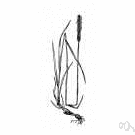Valeria- Species Cerastium
Phleum Saxifraga nella (A) [S.sub.ii] of plants Cerastium 0.168 0.329 0.153
Phleum 0.437 0.573 0.489 Saxifraga 0.672 0.498 0.549 Valerianella 0.614 0.539 0.78 (B) [S.sub.ii] of clump centers ([P.sub.stop] = 0.60) Cerastium -0.061 -0.034 -0.064
Phleum -0.204 -0.046 -0.032 Saxifraga -0.076 -0.033 -0.053 Valerianella -0.171 -0.203 -0.159 (C) [SI.sub.ij] using r = 30 mm(*)
Phleum 1.00 Saxifraga 1.23 1.15 Valerianella 1.28 1.08 1.06 Note: Significant deviations from null expectations are shown in bold (P = 0.05), with allowances made for multiple comparisons.
propos.) richer in oligotrophic bog species (Carex canescens, Juncus filiformis,
Phleum alpinum) that are lacking in the Oroiberian and Carpetan-Leonese bogs.
Reduced seed set in Elytrigia repens caused by allelopathic pollen from
Phleum pratense.
Seeds of a grass mixture (smooth meadow-grass, Poa pratensis; red fescue, Festuca rubra; and perennial ryegrass,
Phleum pratense) (each approx.
(5) Field-cured grass hay (mostly Lolium perenne, Lolium multiflorum and
Phleum pretense); oven-dried, then ground using a blender for 5 min.
For comparison, the pollen grains of ragweed (Ambrosia spp.) and Timothy (
Phleum pratense L.) are 20 and 34 [micro]m in diameter, respectively (Raynor et al., 1972).
The ISAAC panel of six aeroallergens was used: Dermatophagoides farinae, Dermatophagoides pteronyssinus, cat, Alternaria tenuis, mixed tree pollen (Betula verrucosa, Alnus glutinosa, Corylus avellana), and mixed grass pollen (Dactylis glomerata, Lolium perennae, Festuca pratensis, Pod pratensis,
Phleum pratense, Avena eliator).
rubra,
Phleum pratense, and Poa pratensis as common non-indigenous species found in the fields.
(1996a, b) investigated vegetation characteristics within 108 six to eight year old CRP fields initially planted either to timothy (
Phleum pratense L), orchardgrass (Dactylis glomerata L), or smooth brome and legumes.
The experimental site was located within a midsuccessional old field (20-30 yr postagricultural abandonment) that was dominated by introduced perennial grasses: Bromus inermis, Agropyron repens, and
Phleum pratense.
They are rich in Cirsium acaule and Onobrychis viciaefolia, in addition to
Phleum pretense, Scabiosa tomentosa, Brachypodium phoenicoides, Carex hallerana, etc.
Vegetation consisted of cool-season grasses, primarily of smooth brome; in some instances, other species were present including Kentucky bluegrass, orchard grass (Dactylis glomerata), timothy (
Phleum pratense) and a wide variety of forbs.
 Phleum - grasses native to temperate regions
Phleum - grasses native to temperate regions